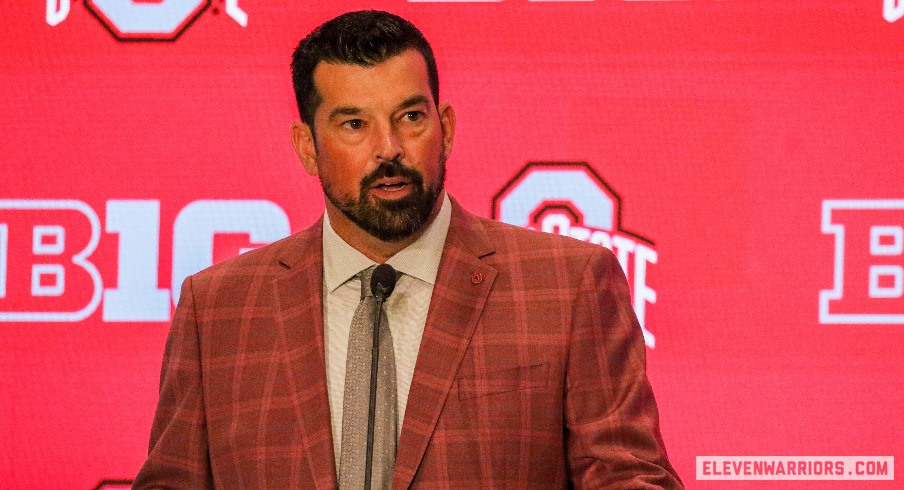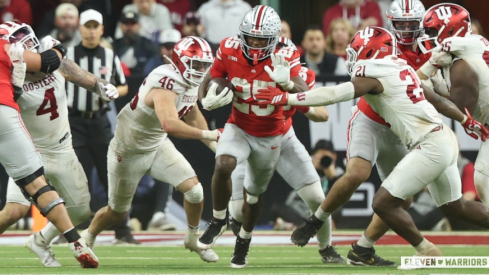Big Ten head coaches are tired of pretending their conference schedules and the SEC’s are on an equal playing field.
No, it’s not because of the supposed depth of the respective leagues, as some of the latter conference’s coaches have claimed, even though the SEC hasn’t played for a national championship either of the last two years.
The reasoning is much more concrete. Big Ten teams play nine conference games every year. SEC teams only play eight. And Ryan Day and Curt Cignetti don’t think that fact gets enough attention.
It’s part of the impasse between the conferences on what the future College Football Playoff model will be.
“I've said this before, that I feel like until there's continuity between the conferences, if you're in the Big Ten, it would make no sense to have anything other than a case to have four (automatic) qualifiers and have an expanded pool of teams, 14 or 16,” Day said. “When you play nine conference games, it's not the same as someone who plays eight conference games. We've said this before. And so if you're going to be compared against that, then it's just not the same.”
Indiana, Cignetti’s squad, made small headlines last week when it canceled its home-and-home series with Virginia scheduled for the 2027 and 2028 seasons. The Hoosiers paid the Cavaliers a $500,000 cancellation fee. Their head coach pointed directly to the weak non-conference slates of some SEC schools, which play only eight conference contests, as a reason why.
“That was a scheduling philosophy that began before I was hired, but I did sign off on it upon being hired before our first season,” Cignetti said. “Here’s the bottom line. We picked up an extra home game, and we play nine conference games. The two best conferences in college football, any football guy that’s objective will tell you, is the Big Ten and the SEC. Twelve of the 16 SEC teams play three (Group of Five) or FCS games. Twelve of those teams play 36 games, 29 G5 games and seven FCS games. And one less conference game. So we figured we’d just adopt SEC scheduling philosophy.”
Day made veiled threats that marquee non-conference matchups like Ohio State’s season opener against Texas this season could go the way of the dodo for his program if the future CFP structure isn’t similar to what the Big Ten is pushing for. It does ring somewhat hollow when the Buckeyes will play the Longhorns again in 2026, Alabama in 2027 and 2028 and Georgia in 2030 and 2031, games Day said he’s not considering removing, but it speaks to similar thought processes of coaches throughout the Big Ten.
“If we're going to be in a situation where we get four automatic qualifiers, then I think it'd be great to have a 10th game against a Power Four team. I think it'd be great,” Day said. “If we're not going to do that, then I don't think it makes sense to do that. I think that you have your nine conference games and then schedule other games with nonconference opponents that maybe aren't in the Power Four.”
This entire conversation stems from a broader disagreement between the Big Ten and SEC about what the CFP format should entail.
It should be 16 teams. That much they can agree on. But the coaches and SEC commissioner Greg Sankey want five automatic bids for the top five conference champions and 11 at-large bids, while the Big Ten put its foot in the ground for its proposed 4-4-2-2-1 structure at Big Ten Media Days on Tuesday. That’s four automatic qualifiers from the Big Ten, four from the SEC, two each from the Big 12 and ACC, the highest-ranked conference champion from the Group of Five and three at-large bids.
“Why shouldn’t the Big Ten have four AQs? Ohio State actually finished fourth in the conference at the end of the season,” Cignetti said. “Indiana and Penn State were tied for second, (Penn State) won the tiebreaker. Ohio State won the national championship. You want to put the best teams in the playoffs? Give the best teams the AQs, but make them earn it with play-in games. And we wouldn’t be opposed to Big Ten-SEC regular season games every year. We need to standardize the schedule across the board if we want to have objective criteria for who should be in the playoffs and who shouldn’t.”
“When you play nine conference games, it's not the same as someone who plays eight conference games. We've said this before. And so if you're going to be compared against that, then it's just not the same.”– Ryan Day
Cignetti also called for the addition of play-in games, which would pit the Big Ten’s third-place team against its sixth-place team and its fourth-place team against its fifth-place team on conference championship weekend with CFP spots on the line. It’s another intriguing part of the league’s proposed playoff structure, and something Big Ten commissioner Tony Petitti called for as part of the 4-4-2-2-1 format.
For Petitti’s part, he said that it’s “not a must” that the Big Ten and SEC play the same number of conference games. But in a potential system with 11 at-large bids, it’s “simple math” that the Big Ten is guaranteed nine extra losses by playing an additional conference game. He and the other leading voices in the conference want CFP selection taken out of the hands of the CFP selection committee as much as possible.
“What are we doing to get the selection process right? So I think those two things go hand in hand,” Petitti said. “First is how many conference games are we playing? And then secondly, what's the selection process gonna be? People have talked about improving the committee's work. I believe the committee does a great job with what they have, and I've yet to hear any member tell me that more data will make the job easier. They have a lot of things in front of them. We went through a mock selection, we saw it. And so I just think those two things have to go hand in hand.”
If the Big Ten gets the CFP format it wants, a lot of the conversation around conference schedules is likely to go away. But the calls for action and balance will only intensify if the safety net of automatic qualifiers isn't installed – and it will impact non-conference scheduling into the future.
“You play one more conference game, and so you can say, all right, that's one more conference game,” Day said. “But then also, it's one more conference game for everybody in the conference. So somewhere along the line, whoever's playing each other in that last game is going to get a loss. So, when you have a win in Week 4 against a team that loses that extra game, that win may not look as good. It's just one more loss. Now, it's one more win, but it's one more loss for the entire conference. That's different.”


